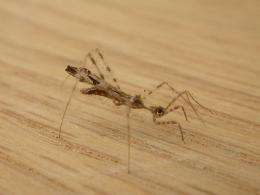October 28, 2010 report
Assassin bugs trap spiders by mimicking prey (w/ Video)

(PhysOrg.com) -- Scientists in Australia have described how assassin bugs lure spiders to their deaths by plucking the silken threads of the spider’s web with their legs to replicate the vibrations made by wriggling prey.
The researchers, Anne Wignall and Phil Taylor from Macquarie University in Sydney, Australia, observed assassin bugs (Stenolemus bituberus) mimicking prey to lure tangle-web spiders towards them. When the spiders arrived within reach the bugs tapped them with their antennae and then stabbed the doomed spiders with their sharp, dagger-like snouts.
The behavior, described in the journal Proceedings of the Royal Society B, is known as “aggressive mimicry” and is one of two strategies assassin bugs use to trap their prey. The other behavior is to stalk the spiders, slowly approaching until they are within range.
Web-building spiders detect struggling prey by the vibrations of the silk threads, but there are other possible sources of vibrations, including the presence of mates and debris. The researchers aimed to compare the responses of the spiders to prey (flies and aphids), the presence of courting males, leaves falling into the web, and vibrations caused by assassin bugs. They filmed each encounter with a high-speed video camera and recorded the vibrations in the web using a laser.
Their results showed there were significant differences in the way the spiders behaved towards vibrations of different sources. The spiders did not generally respond to vibrations caused by leaves falling on the webs, and when the vibrations were caused by male spiders, the females tended to adopt the characteristic position to accept copulation.
In response to the vibrations made by struggling prey, the spiders always turned towards the prey and approached, either by a rapidly moving without pause, reaching the trapped insect in under a second, or by a more leisurely approach. The rapid response was reserved for strong, newly trapped insects or those frantically beating their wings, and the leisurely response tended to be reserved for exhausted or weakly struggling prey. The response to the vibration set up by assassin bugs mimicked that of the weak prey.
The vibrations produced in the web by weakly struggling prey or the assassin bugs differed from those produced by falling leaves or insects first hitting the web in that they lacked the large initial wave caused by the impact. They also differed from those produced by courting males, which include a distinctive set of repeated vibrations that enabled the females to identify the source as a courting male.
The assassin bugs were not always the victors, and the researchers said they had “observed bugs being counter-attacked, killed and eaten by the spider they were hunting.” This risk was much greater if the spider approached aggressively and without pause.
More information: Assassin bug uses aggressive mimicry to lure spider prey, Anne E. Wignall and Phillip W. Taylor, Proceedings of the Royal Society B, Published online before print October 27, 2010, doi: 10.1098/rspb.2010.2060
© 2010 PhysOrg.com

















